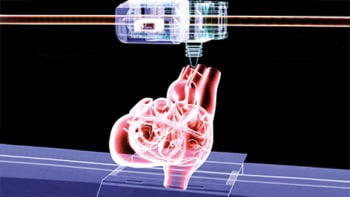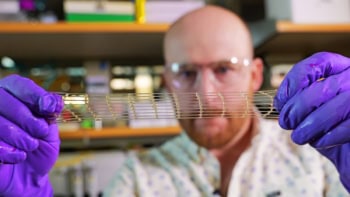
In the early stages of cancer drug development, candidate molecules are tested on tumour cell lines grown in 2D and 3D models. But there is poor correlation between these models and “true” human tumour pathophysiology, often leading to overestimation of drug efficiency.
The biochemical and mechanical cues of the 3D network of extracellular molecules, known as the extracellular matrix (ECM), are thought to be critical to tumour progression, and so models are being developed to better reflect these cell–matrix interactions. Current 3D models are based on synthetic materials or derived from natural components, but display deficient cellular adhesion and ECM-like mechanical stiffness, respectively.
This has led researchers to investigate a new type of 3D model – tissue scaffolds, prepared by removing cells from sections of animal tissue. There have been promising results growing cancer cell lines in decellularized rat lungs, and this spurred teams in China and Australia to examine models made from an animal with closer genetic compatibility to humans – the pig.
The scientists have now thoroughly examined the structural and biomolecular features of porcine lung sections, characterized breast cancer cell growth within the scaffolds, and tested the model’s sensitivity to a chemotherapeutic agent (Biofabrication 10.1088/1758-5090/aae270).
“Our various analyses demonstrate that our organotypic tumour model based on decellularized lung scaffold provides a promising alternative to study the biology of breast cancer and examine drug response,” says first author Wenfang Li from the Dalian University of Technology, China.
Evaluating the scaffold
Li and the team dissected tissue from frozen porcine lungs and decellularized them using chemicals commonly found in detergents. Microscopy and histology were used to confirm that all the cells were removed, and Masson’s trichrome staining (along with more advanced Raman spectroscopy techniques) confirmed that a critical component of the ECM, collagen, was preserved. Collagen fibres are cleaved by decellularization and, as this impacts adhesion, the team decided to use a chemical cross-linker to restore collagen.
They then examined the physical and mechanical structure of the porcine scaffold, using a variety of methods including scanning electron microscopy to examine pore size and compression experiments to evaluate mechanical strength.
“The decellularized lung scaffolds had favourable biomechanical characteristics,” says Li, pointing out that the porous structure was critical for adhesion and crosslinking improved the mechanical strength to levels comparable with patient tumours.
Supporting growth
Li seeded the millimetre-scale porcine scaffold with MCF-7 breast cancer cells, and tumouroids formed within three days. Confocal microscopy of fluorescently stained structural proteins confirmed the complete infiltration of the scaffold, with adhesion to the porous surface and cellular aggregation. The presence of viable, proliferating cells that caused the tumouroid mass to grow, provided further evidence that the decellularized porcine lung scaffolds have good biocompatibility as a tumour model.
The team also found that as the tumouroid increased in size, more internal cells were starved of nutrients and oxygen and so experienced cell death. This localized lack of oxygen, and subsequent cell death, is promisingly similar to the conditions observed in large tumours within patients.
Another encouraging sign of the model’s correlation with in vivo tumour growth was a noticeably stronger expression of breast cancer malignancy markers within MCF-7 cells in the 3D porcine scaffold, than that found in 2D cultures of the cell line.
Testing treatment
Finally, at 14 days post-seeding, tumouroids within the porcine scaffold were treated with the chemotherapeutic agent, 5-FU. The team found markedly less cell death in their new model than in MCF-7 cells grown in 2D cell culture, and this higher level of drug resistance is suggested to be due to enhanced cell–cell contacts in the closely packed tumouroid clusters.
“Another application of the lung scaffold is to serve as the model of breast cancer metastasis, as lungs are one of the most common sites for metastatic colonization,” said Li, who plans to investigate this metastatic mechanism in future studies.
However, when comparing cell survival after 5-FU treatment in a 3D model that utilizes a popular tissue engineering scaffold (chitosan/gelatin), the team didn’t find a significant difference in the drug resistance. Although the porcine model has the advantage of simple and cost-effective preparation, whether it is a better representation of in vivo tumour growth over the current 3D models remains to be seen.
Li points out that “real tumours” are formed by various cell types and tissues. “Thus, we aim to develop a more complex tumour model with diverse cell types and vascular system, to more accurately represent the tumour microenvironment in vivo” says Li.



